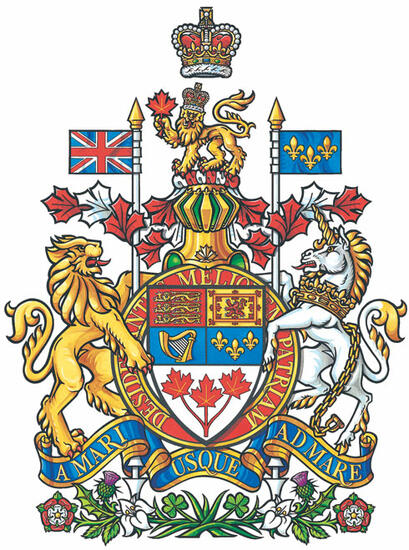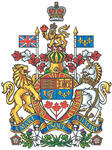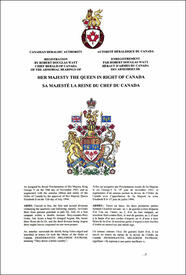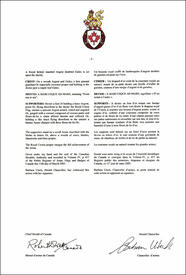The contents of this Register are intended for research purposes only. The heraldic emblems found in the Register may not be reproduced in any form or in any media without the written consent of the Canadian Heraldic Authority and/or the recipient.
Ottawa, Ontario
Registration of the Arms and Supporters of Her Majesty The Queen in Right of Canada
March 15, 2005
Vol. IV, p. 457
Arms of Her Majesty the Queen in Right of CanadaBlazonTierced in fess, the first and second divisions containing the quarterly coat following, namely, 1st, Gules three lions passant guardant in pale Or, 2nd, Or a lion rampant within a double tressure flory-counter-flory Gules, 3rd, Azure a harp Or stringed Argent, 4th, Azure three fleurs-de-lis Or, and the third division being Argent three maple leaves conjoined on one stem proper;
SymbolismThe sprig of three maple leaves represents all Canadians, the maple leaf having been used as a Canadian symbol since the early 19th century. The other four quarters (i.e., sections) of the shield are the royal emblems of the United Kingdom and France: the three lions of England, the lion within a double tressure of Scotland, the harp of Ireland and the fleurs-de-lis of France.
|
CrestBlazonOn a wreath Argent and Gules, a lion passant guardant Or imperially crowned proper and holding in the dexter paw a maple leaf Gules; SymbolismDerived from the royal crest of England, a standing gold lion wearing a crown, the crest of Canada includes a red maple leaf as a national emblem. Above the crest is the Royal Crown. Used on its own, the crest is the symbol of the Governor General of Canada. |
MottoBlazonA MARI USQUE AD MARE; SymbolismMeaning “From sea to sea,” this Latin phrase is taken from the verse “He shall have dominion from sea to sea and from the river unto the ends of the earth” (Psalm 72:8). It alludes to the vastness of the geography of Canada. |
SupportersBlazonDexter a lion Or holding a lance Argent, point Or, flying therefrom to the dexter the Royal Union Flag, sinister a unicorn Argent armed, crined and unguled Or, gorged with a coronet composed of crosses-patée and fleurs-de-lis a chain affixed thereto and reflexed Or, holding a like lance flying therefrom to the sinister a banner Azure charged with three fleurs-de-lis Or; The supporters stand on a scroll Azure inscribed with the Motto in letters Or, above a wreath of roses, thistles, shamrocks and lilies proper; SymbolismThe lion and the unicorn were originally used as the supporters of the royal arms of England and Scotland respectively. The flags that they hold are the Royal Union Flag (Union Jack) and the Royal banner of France respectively, an acknowledgement of the two countries from which Canada’s legal and governmental institutions are derived. The flowers at the base are also emblems of these nations: the Tudor rose of England, the thistle of Scotland, the shamrock of Ireland and the lily of France. |
Additional InformationCreator(s)Not applicable PainterCathy Bursey-Sabourin CalligrapherNot applicable Recipient TypeCivil Institution
Other InformationThe recipient’s emblems were approved by Order in Council on April 21, 1921, and by Royal Proclamation on November 21, 1921. |




